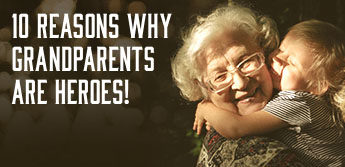
10 Reasons Why Grandparents Are Heroes!
Nanny and Grampa. Mimi and Pop-Pop. No matter how the kids address them, one thing is for sure, Grandma and Grandpa are heroes. READ MORE

By Darlene Cah
Key Takeaways
Classic, chic. Moody, mysterious. Frightening, foreboding. Exuberant, exciting. Black and white films and TV shows evoke all the emotions of color film, but with a direct connection to entertainment history. Glamorous stars like Amanda Blake, Marilyn Monroe, Barbara Stanwyck, Katharine Hepburn, Bette Davis and others captured hearts in black and white. Even Maureen O’Hara, the acclaimed Queen of Technicolor, starred in stunning black and white films, including Rio Grande (1950) with John Wayne, Miracle on 34th Street (1947) with a young Natalie Wood, and O’Hara’s first major movie role in Jamaica Inn (1939) directed by Alfred Hitchcock.
Seeing the Light
 From the very early days of filmmaking, makeup artists (often the actors themselves) faced the challenges of how certain film types “read” different colors and light.
From the very early days of filmmaking, makeup artists (often the actors themselves) faced the challenges of how certain film types “read” different colors and light.
For example, orthochromatic film was sensitive to only blues and greens. So, reds appeared black, and any variations in an actor’s skin tone would look smudgy and dirty. They compensated for the differences by applying blue makeup to create contour and yellow for lipstick.
When panchromatic film, which was sensitive to every visible color in the spectrum, became available, actors could rely on more natural colors or if the cinematographer preferred, no makeup at all, choosing to create a beautiful picture with lighting alone. But still, different lights affected the overall look. Max Factor saw a need and developed makeup in colors and tones that lent itself to creating a blended, natural look under any light.
Along Came Black and White TV
Though television sets were available in 1939 and both NBC and CBS established broadcast stations in New York City, most people still got their news and entertainment by listening to the radio—comedy and variety shows like Abbott and Costello, and The Jack Benny Program, soap operas like The Guiding Light, and the Western drama, Lone Ranger. Television was considered a fad, but soon the fad became the norm and the norm became a necessity.
Prior to 1946, black and white television shows presented their own special makeup challenges. Because of the way television signals transmitted, the picture appeared in lower definition than movies on the big screen. The iconoscope camera tubes translated colors into shades of gray, but the television cameras did not record red in the actors’ faces. The result was a completely flat-looking face, almost like a cartoon. The makeup had to create the illusion of contrast. Using green instead of red in the makeup palette added depth and a more natural picture. Makeup was more clownish and just plain strange. Green blush. Green lips. Green eye shadow. It was surreal, like something from outer space. But on the small box, stars like Betty Grable looked glamorous. To complicate matters, depending on the color of the lights used and the definition of the broadcast picture (very low definition rendered a blurry picture), makeup colors would have to change. They often used purple contour along the sides of the nose, under the eyes, and to delineate laugh lines.
 After World War II, television took off and Westerns became all the rage from the early 50s well into the 70s—from Gunsmoke to Cheyenne to Wagon Train and The Rifleman, with a recent resurgence thanks to shows like Yellowstone, and its multiple prequels, 1883 and 1923. As more people bought TV sets the technology kept up with the demand. Cameras were now able to reproduce images in black and white that were more realistic, so actors could wear makeup closer to natural colors. Almost.
After World War II, television took off and Westerns became all the rage from the early 50s well into the 70s—from Gunsmoke to Cheyenne to Wagon Train and The Rifleman, with a recent resurgence thanks to shows like Yellowstone, and its multiple prequels, 1883 and 1923. As more people bought TV sets the technology kept up with the demand. Cameras were now able to reproduce images in black and white that were more realistic, so actors could wear makeup closer to natural colors. Almost.
Max Factor, being at the forefront of both film and early television makeup, developed guidelines and a new palette for “modern” TV, advising the “cautious” use of blue eyeshadow, as it always appeared darker on the small screen. Men’s beards, even a light shadow on a shaved face would look like splotchy dirt, so makeup artists applied light putty-colored grease as a base layer. Shadows under actors’ eyes had to be extra-highlighted—even on the young, fresh-faced ingenues.
Every actress who wore false eyelashes had to be tested on camera individually. On some, their eyes were enhanced and enlarged. On others, the lashes created black, gaping holes on screen. Miss Kitty, however, apparently had no problem batting her gorgeous eyelashes at the ever-dashing Marshal Dillon.